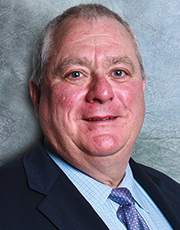
NorthMarq
President John F. Kennedy once said that “Change is the law of life. And those who look only to the past or present are certain to miss the future.” When it comes to the current state of the commercial real estate market change is all around. Whether it is the economy and interest rates, technology advances, and lending strategies, the only constant is change.
The market sentiment for commercial real estate investing is still mostly optimistic but predicting the future is still an art and not a science and always subject to change. For example, economists have been predicting for several years that we will be facing an economic slowdown in “the next 18-24 months.” Despite international trade turmoil most economists still predict that 2019 will be a healthy year, which is good for all real estate.
Though the yield curve is inverted, long term interest rates are at their lowest level in several years making long term mortgage rates very attractive to the Borrowing community. Late last year folks worried about borrowing at 5% - sub 4% anyone? What a change in six months!
Technology has played a major role in improving transaction due diligence not only in terms of data availability but also in terms of our ability to compile, analyze, and make judgments based on that data. Data analytics in commercial real estate will continue to gain prominence in the months and years ahead as more are introduced into the real estate ecosystem. Costar, REIS/Moody’s Analytics, TREPP, CrediFi, Axiometrics, CoreLogic, and Real Capital Analytics are all major players in the real estate finance industry and are integral in analyzing debt and equity investments. Because of analytics, the approach of lending community to new commercial loans has continually evolved over the years. According to a recent research report published by Trepp vintage CMBS securitization pools (pre-2008) that had high levels of credit exemplified by lower weighted average LTV ratios (sub 60%) and higher debt service coverage ratios (>2.0x) and higher debt yields (>10%) all showed minimal losses with few write-downs.
Today, CMBS lenders are most competitive when they quote senior loans of 60% and less. They will do full term interest only at those levels. Some CMBS shops will lend upwards of 70% LTV but generally they are lenders that buy their own “B” Notes and are paid to take the additional risk associated with these loans. Amortization is key as are leasing reserves and cash management. Pricing for 10 year CMBS loans ranges from 200-210 over swaps for a 60-65 % LTV loan and upwards of 275 over swaps for a 70%+ LTV loan. Terms can range from 5-10 years in length.
Life Insurance company lenders, long the bellwether for commercial real estate lending trends all continue to desire lower-leveraged, higher-quality, best-of-class mortgage loans, eschewing risk for safety. Today, aggressive pricing spreads (sub 150) are available for loan opportunities that are sub 50% LTV, +1.50x DSC, and +10% debt yield transactions. On a grid basis, pricing for 60-65% LTV life company loans are 165-180 over for ten year loans. Money is available for terms as short as 5 years and fully amortizing up to 30 years.
Other capital sources who provide fuel to the lending market are the GSEs consisting of Freddie Mac, Fannie Mae, and FHA/HUD. They are the most active multifamily lenders in the country, but they too have a continued measured approach to lending. Freddie and Fannie will lend up to 80% LTV at spreads of range from 170-210 over treasuries. Loan terms are generally 5-15 years in length.
Regional banks and credit unions have tightened underwriting on account of new regulation and economic concerns and are not as competitive, than in the past. In contrast, money for bridge lending from private equity firms is more available now than at any time in the recent past. Generally non-recourse these loans at 75 percent of value and pricing is generally 250-350+/- bps over Libor (or higher) depending on the risk of the business plan to reposition the asset.
Spreads in this space have tightened 100 basis points or more in the past 12 months as more and more lenders have entered into this market. Most paper in these markets are for terms of less than 5 years.
All of these lenders have a desire to maintain discipline with respect loan underwriting metrics. As capital continues to chase the best deals, lenders are holding to debt yield, LTV and debt service constraints, and are insisting on getting paid for risk. Unlike past cycles, borrowers have not been pushing the envelope on trying to finance real estate projects. In many respects borrowers are just as disciplined as lenders.
With the third quarter about to commence, investors with financing needs will have to meet market changes head-on in order to achieve desired financing levels.
Ernest DesRochers is senior vice president and co-managing director at NorthMarq’s New York regional office, New York, NY.








